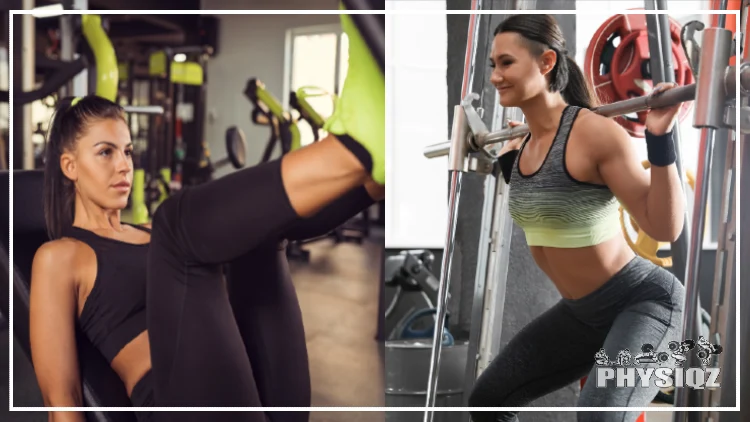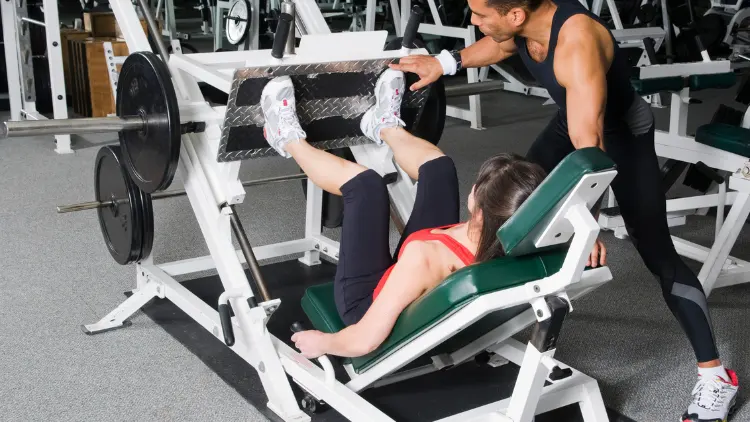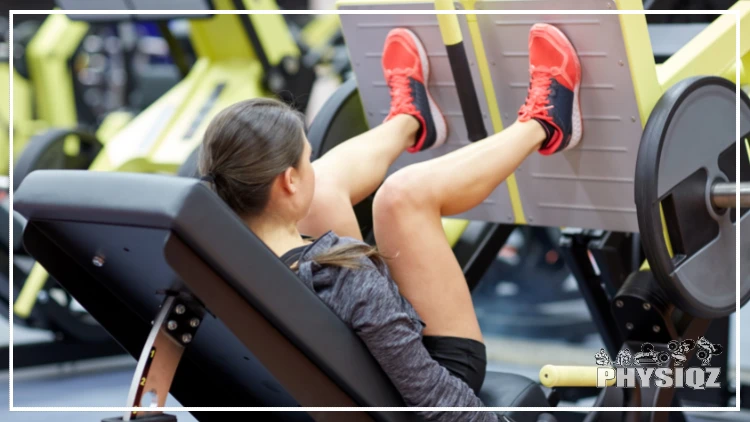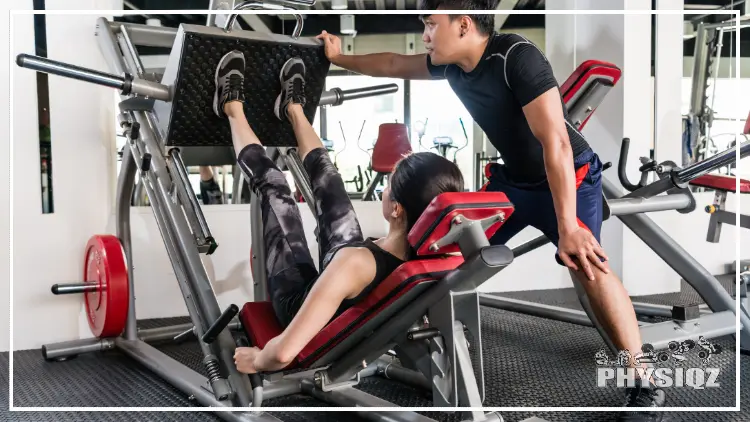
Understanding the leg press to squat conversion can help you decide which weight to try when moving from one exercise to another.1
This is because many people start out using machines in the gym before trying free weights, and this transition often brings questions about leg press to ratios once a lifter is ready to transition to barbell squats.
A person’s leg press weight is often hundreds of pounds more than their back squat, which can make it hard to know what weight to start squatting at. Conversion also becomes tricky because a lack of experience with free weights can limit squat performance.
However, there’s a trick to estimating leg press to squat ratio and we’ll explain exactly how to calculate it, the reasons why it’s so much easier, and a safety protocol when going figuring out how much you should squat in relation to the leg press.
Reasons Why Leg Press Is Easier & Allows You To Lift More Weight Compared to Squats
Virtually everyone finds that they can leg press far more weight than they can squat. For the most part, this comes down to mathematical factors that can be calculated and solved. By applying core concepts from trigonometry and physics, it’s possible to calculate the ratio from a diagonal leg press weight to a vertical squat weight.
First of all, consider the difference between mass and weight.
While the mass of an object is constant, weight is the force that gravity creates by pulling on that object. When a person lifts an object directly upward (vertically), they work against the full weight of the object, which equals its mass. Pushing that same mass diagonally does not involve pushing the same weight or exerting the same force, though.
Plus, the leg press is simply an easier exercise than the squat on account of the fact it isolates the glutes.
Squats are full-body exercises that create a considerable spinal load and put pressure on the erectors, the core, and the upper body. Strong quads and weak supportive muscles will result in an extremely low squat weight or dangerously bad form.

Source: leezsnow via Canva.com2
Another important factor to consider when comparing my ability to do leg presses versus squats is body weight. Leg presses don’t involve any body weight, but a free squat requires a person to move the bar, plates, and more than half of their body weight. This is a major factor to take into account to convert leg presses to squats, and it’s going to vary by each person.
It’s not only about how much a person weighs, either – a taller person has longer internal levers, which means they have to exert more force to move the same weight while squatting. Comparing an equally strong, equally heavy short person and tall person would reveal that the short person could squat more weight and perform more reps.
Understanding the impact of your genetics on your squat form is important to accurately estimate the conversion from leg press to squats, and to perform squats safely.
By using trigonometry, anyone can see that the weight someone pushes on a 45-degree leg press is only about 75% of its mass.
The next step is to subtract the body weight a person lifts during a squat, probably about 70% of their body weight. If a 200 lb person can push 630 lbs on a leg press, it would make sense that they could squat about 300 lbs. However, this isn’t the whole picture.
Is There a Standard or Universal Ratio Between Leg Press & Squat Weights?
In reality, there isn’t a specific leg press to squat ratio and this is because of the differences in angles between the lifts and various machines, the height and weight of an individual, and squats are a multi-joint, compound movement while the leg press focuses more on the quads alone.
To elaborate the first point, not all leg press machines use the same angle. As the angle of the leg press moves further from vertical, the actual force a person pushes drops at different rates. Each individual leg press may have a different angle and sin, which changes the ratio between leg press weight and squat weight.
Choosing between high bar vs low bar squats or different stances and techniques make a major difference to squat performance, as well.3
Second, the height and weight of each person are factors that would demand their own ratio. If it were just trigonometry and body size, then it would be possible to perfectly calculate a leg press to squat ratio with enough help. The biggest obstacle, though, is the fact that leg presses and squats are two different exercises that don’t transfer neatly to each other.4
While they both target the same primary muscles, the machine does little to engage any secondary muscle groups. In comparison, the squat is a full body exercise that offers more diverse benefits and engages many secondary muscles, which makes it better for a hypertrophy mass routine but also more challenging.5
Maintaining balance, good form, and a proper squat bar path in a squat requires considerable core and upper body strength, neither of which leg presses contribute to.
That’s not to say that squats are simply superior to the leg press, though. For one, there are more factors that can limit squat performance , and the leg press is easier to perform safely compared to other leg extension exercises.6, 7
Sports hernias from squats are more likely than hernias from performing a leg press, for instance. In cases like this, more controlled exercises like leg presses are less likely to provoke a chronic sportsman’s hernia.8 All else being equal, anyone who trained primarily in one technique is going to underperform in the transition to the other.
A person who makes the leap from the leg press to squats may find that their less-developed supporting muscles prevent them from squatting a theoretically equal amount of weight. On top of that, they’ll need time to develop the proper form and technique for a squat.
By the same token, someone who primarily squats is used to these secondary muscles sharing the load and doing part of the work. They might find that they perform below expectations on the leg press, since it focuses the weight onto a smaller group of muscles.
Math is the main reason for the disparity between leg press and squatting weights. However, that’s simple to calculate and resolve. The differences between the leg press and squat are the main reason that there’s no instant, perfect conversion between the two exercises.
Nonetheless, the leg press weight to squat weight conversion method still offers useful insight. The remaining difference is mostly technique and conditioning, which means that a person can reach their squat conversion weight fairly quickly with proper training.
Leg Press To Squat Conversion: Ways To Calculate Leg Press Weight to Squat Weight
When W equals weight, A equals angle and M equals mass, it’s possible to calculate the real force being pushed with the formula W x sin(A) = M. This may sound complex, but it’s not too bad if you’d like an estimation on what to squat after leg press – if not, you’ll just have to wing it.

Source: SYDA Productions via Canva.com9
Take the example weight of 600 lbs and the traditional 45-degree leg press angle, and so far the leg press weight to squat weight conversion math looks like:
600lb x sin(45) = approximately 425lb
The next step is to account for body weight. Different heights and body types mean a person will lift different proportions of their weight during a squat, but it should be more or less 60-75%. If a person wants to convert their leg press to squat, the next step is to define two more mathematical factors.
This is B, which equals 70% of that person’s body weight. By subtracting B from M, a person reaches S, the equivalent squatting weight.
Imagine that a person who weighs 200 lbs pushes 600 lbs on the leg press, and wants to know how that measures up to squats other people of a similar weight are performing. That would look like:
B=70% of 200 lbs=140lbs.
600lbs x sin(45) = M = 425lbs.
Then, M-B=S.
425lbs – 140lbs = 285lbs.
Factoring in the effect of diagonal movement on mass and a person’s body weight caused this 600 lb leg press to drop down to a 285lb squat. While a shorter, smaller person’s leg press might be closer to a 335lb squat, a larger person might hew closer to a 240lb squat. Either way, the bottom line is that doing leg presses can double or even triple the weight that a person can push.
Is the Leg Press Weight To Squat Weight Conversion Accurate?
Leg press to back squat conversion is accurate, to an extent. The first step, converting plates on the leg press into plates on the back squat is simple trigonometry and 100% accurate. Accounting for the exact amount of body weight in a squat has a modest margin of error, but not so much as to make the conversion inaccurate.
After completing both of these steps, a person will have an accurate idea of how much weight they’re pushing on the leg press compared to a squat. However, that does not necessarily mean they’ll be able to squat that much immediately.
Comparing the Difficulty of Smith Machine Leg Presses To Traditional Leg Presses & Squats.
Overall, a Smith Machine is the closest that any machine-based exercise comes to the standard squat. According to electromyographic testing, back squats and repetitions on a Smith Machine are fairly similar exercises.
However, three specific muscles reach considerably higher levels of activity with traditional squats; the biceps femoris, gastrocnemius, and vastus medialis. This translates into a greater level of overall muscle activity for the squat, which is the first major difference between the two.
Another notable difference between the two is that the bar on a Smith Machine is functionally weightless due to the way the machines work. This saves between 15 and 25 pounds, which is going to decrease the amount of weight a person will be able to handle after transitioning to a squat.
Finally, the last reason that a Smith Machine is easier than a free weight squat is balance. The machine forces the user onto a narrow plane of movement and eliminates much of the need for proper form and coordination.
This is the biggest reason why someone will initially squat considerably less if they’ve been training on a Smith Machine.
That said, a Smith Machine is considerably more challenging than a traditional leg press. For one, it involves pushing weight at a vertical, not a diagonal.
Smith Machine To Free Weight Conversion: Ways To Estimate Smith Machine Weight Conversion to Squats
The first and easiest step to take when converting a Smith Machine to free weight is to account for the weight of the bar. A Smith Machine’s weightless bar means that right off the bat, a person will squat about 20 pounds less. Since a vertical Smith Machine stands up straight, there’s none of the complicated math that’s necessary for leg presses.
However, there are important differences that mean someone’s squat will almost always be more than 20 pounds below what they can lift on a Smith Machine.

Source: undrey via Canva.com10
Namely, it’s hard to account for the difference that that form and balance makes, as the stabilizer muscles that are so important in squatting are unknown quantities. A person who trains the core and other stabilizing muscles with different exercises might subtract 10% from their Smith Machine and then another 20 pounds, and be able to squat that.
On other hand, someone with weak stabilizer muscles might find themselves unable to squat more than 60% of their Smith Machine weight.
Leg Press To Squat Calculator Availability To Figure Out Leg Press vs Squat Weight
There are no apps or tools available to instantly calculate the leg press to squat weight conversion. Currently, the closest things that are available are data aggregators that compare statistics across different exercises. This data would reveal the average leg press vs the average squat, but it’s not a reliable guideline for individual conversions.

Source: PRImageFactory via Canva.com11
When someone wants to calculate the force involved in a leg press vs a squat, manual calculation is the only option. That can involve getting a protractor to measure the angle of individual leg press machines before factoring in body weight and height. That’s a lot of work to do for a conversion that doesn’t reliably show how much a person can squat, depending on how developed their stabilizer muscles are.
Converting leg press weight to squat weight is helpful to gauge strength more accurately, but it’s not the best way to switch from squats to the leg press. Leg press weight to squat weight is a useful trick to know how much mass each exercise really involves pushing, but those starting out on squats should always take the following safety protocols too.
Protocol When Going from Leg Press To Squats & Leg Press Squat Conversions Isn’t Possible
A safety-conscious lifter will always take their time working to reach their converted leg press weight when squatting. Before even considering what weight to squat, start setting up safety bars and try to find a spotter. One or the other is a must, especially for someone who’s not used to handling free weight. A spotter is ideal since they can point out bad form, and building good form is the first priority for someone who’s going from leg press to squats.
Under no circumstances should someone without experience squatting go straight to squatting heavy weights. Even if they have all of the core and leg strength necessary, they aren’t going to have the muscle memory for good form. From there, the goal is to start as low as possible and try to find the weight that doesn’t compromise form.
Take a person who can comfortably leg press 600 lbs, for example. Their conversion weight will be somewhere around 200-300 lbs, but they shouldn’t go straight to that. Instead, they can start out doing a set of eight back squats with 90 lbs of weight.
If they held perfect form and didn’t find the weight challenging, they can add another 20 pounds, do another set, and repeat until they find a challenging but doable squat weight. This is a safe, efficient way to develop good form, find the optimal squatting weight, and perform progressive overload training over time.
It takes some math, but it’s nice to know how leg press weight translates over into squatting even though the leg press to squat conversion isn’t perfectly accurate no matter which approach is taken.
References
1bulatovic. Canva. Accessed 18 April 2023. <https://www.canva.com/photos/MADapTgRETs-leg-press-exercise-/>
2leezsnow. Canva. Accessed 18 April 2023. <https://www.canva.com/photos/MAED9cZvbPg-health-club-workout-leg-press/>
3Lorenzetti, S. (2018, July). How to squat? Effects of various stance widths, foot placement angles and level of experience on knee, hip and trunk motion and loading. NCBI. Accessed November 20, from <https://www.ncbi.nlm.nih.gov/pmc/articles/PMC6050697/>
4Rossi, F. E. (2016, October). Strength, body composition, and functional outcomes in the squat versus leg press exercises. NCBI. Accessed November 20, from <https://pubmed.ncbi.nlm.nih.gov/27735888/>
5Wirth, K. (2016, May). The Impact of Back Squat and Leg-Press Exercises on Maximal Strength and Speed-Strength Parameters. NCBI. Accessed November 20, from <https://pubmed.ncbi.nlm.nih.gov/26439782/>
6Myer, G. D. (2015, December). The back squat: A proposed assessment of functional deficits and technical factors that limit performance. NCBI. Accessed November 20, from <https://www.ncbi.nlm.nih.gov/pmc/articles/PMC4262933/>
7Sjöberg, M. (2021, August). NCBI. Accessed November 20, from <https://www.ncbi.nlm.nih.gov/pmc/articles/PMC8374053/>
8Paksoy, M. (2015, August). Sportsman hernia; the review of current diagnosis and treatment modalities. NCBI. Accessed November 20, from <https://www.ncbi.nlm.nih.gov/pmc/articles/PMC4942157/>
9SYDA Productions. Canva. Accessed 18 April 2023. <https://www.canva.com/photos/MACU-UJDOP8-woman-flexing-muscles-on-leg-press/>
10undrey. Canva. Accessed 18 April 2023. <https://www.canva.com/photos/MADer1G1xcE-fit-woman-doing-squats-with-a-barbell-in-smith-machine-/>
11PRImageFactory. Canva. Accessed 18 April 2023. <https://www.canva.com/photos/MADCqvXUzgc-woman-working-at-leg-press-in-the-gym/>